3-D Reconstruction of an Urban Landscape to Assess the Influence of Vegetation in the Radiative Budget
Abstract
1. Introduction
- (a)
- DART spectral domain extends from ultraviolet to thermal infrared, simulating shortwave broadband as weighted integration of narrow bands. Since the solar radiation and optical properties of objects vary dramatically over the spectral domain, the use of DART can provide more accurate results compared to simulation software in which radiation is only assessed in terms of short-wave and long-wave radiation (2 values) and the optical property is only defined by albedo and emissivity of broadband.
- (b)
- DART considers all types of surface optical properties, including isotropic property (Lambertian) or anisotropic property (specular, or predefined bidirectional reflectance distribution function), which extends the applications to all different materials.
- (c)
- DART models multiple scatterings between simulated scene elements in 3-D. This generates more accurate results for scene elements with high reflectance in the short-wave domain, and it permits modeling the gray body (emissivity less than 1) in the long-wave domain.
- (d)
- DART uses a discrete-ordinate forward ray tracing approach, which facilitates an efficient generation of the 3-D radiative budget as opposed to models using backward ray tracing or radiosity approach.
- (e)
- DART can simulate a cluster of leaves as a turbid medium defined by leaf area density, leaf angle distribution, and clumping function. By doing so, it saves the computer memory in storing every single leaf and provides results with high accuracy.
2. Materials and Methods
2.1. Generating 3-D Model of a City Using Open or Commerically Available Data
2.1.1. Pre-processing
2.1.2. Land Cover Classification
2.1.3. Digital Terrain Model
2.1.4. Height Data Extraction
2.1.5. 3-D Scene Creation
2.1.6. Urban Typologies Selection
2.2. Quantification of the Influence of Vegetation on the Radiative Budget of 3-D Urban Scenes
2.2.1. Field Measurements of Leaf Area Density
2.2.2. Radiative Transfer Simulations Using DART
2.2.3. Field Validation
3. Results
3.1. Sensitivity of the Model to Leaf Area Density
3.2. Comparing the Radiative Budget of Different Urban Typologies
3.3. Shortwave Exitance Simulation and Field Validation
4. Discussion
5. Conclusions and Future Work
Author Contributions
Funding
Acknowledgments
Conflicts of Interest
Appendix A. Parameters for Atmospheric Correction Using FLAASH Module

Appendix B. DART Simulation Parameters

Appendix C. Land Cover Map of Singapore
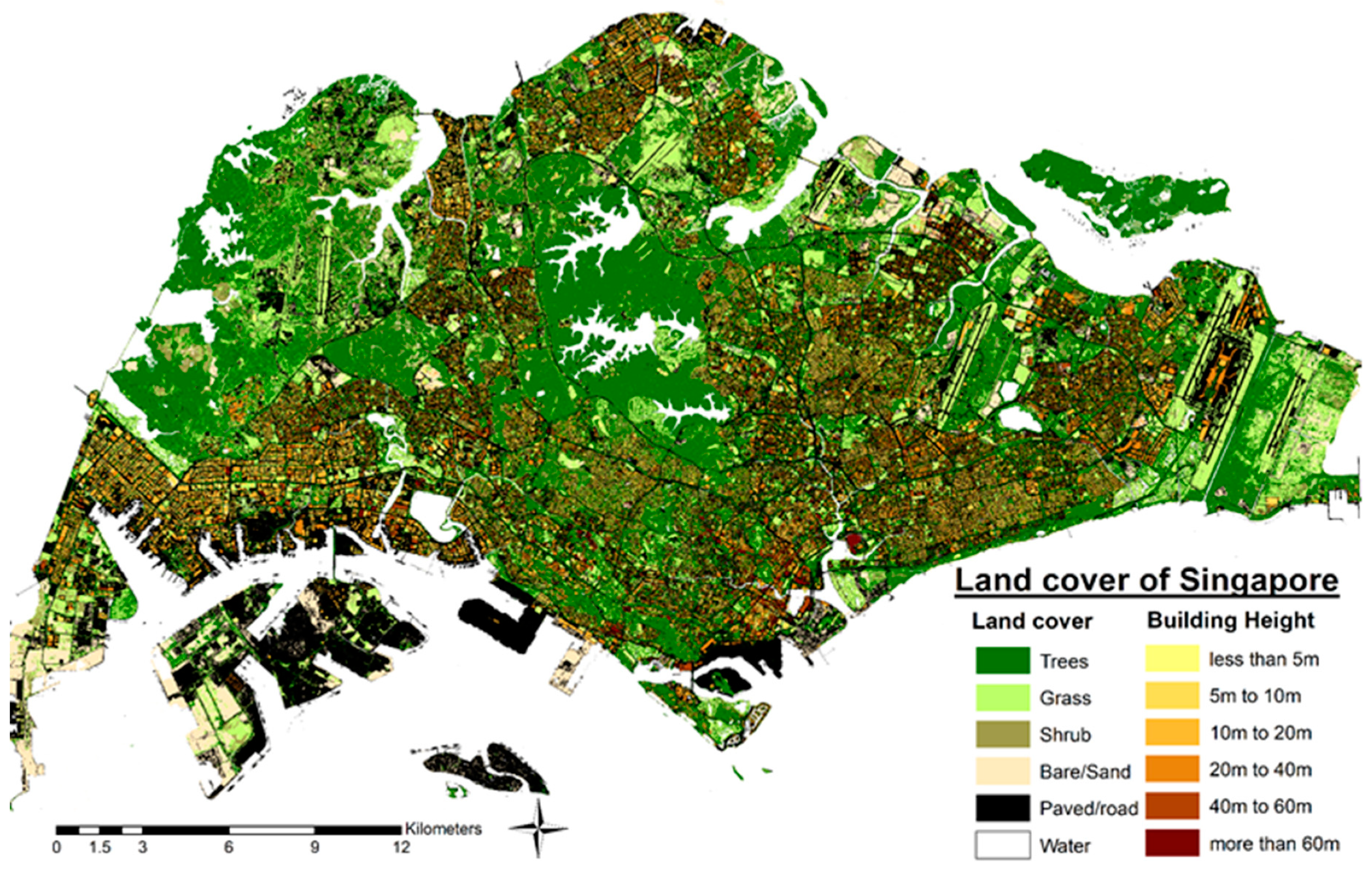
Appendix D. Spectral Reflectance of Construction Materials and Vegetation (from DART Database)
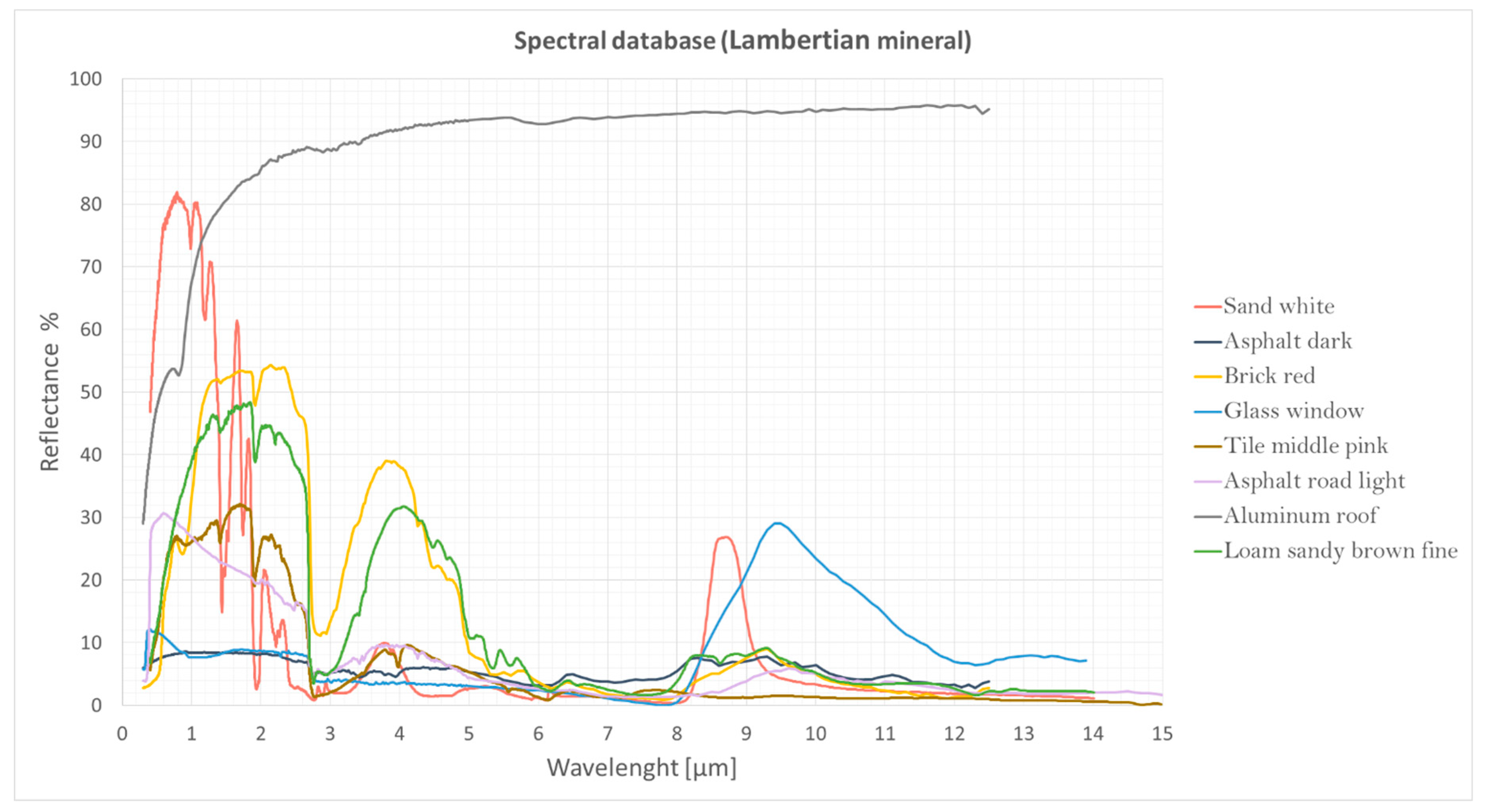

Appendix E. Effect of Different Ground Cover Materials on the Absorbed Shortwave Radiation by Ground and Buildings for T4 and T5 Typologies

Appendix F. Simulation Results Summary
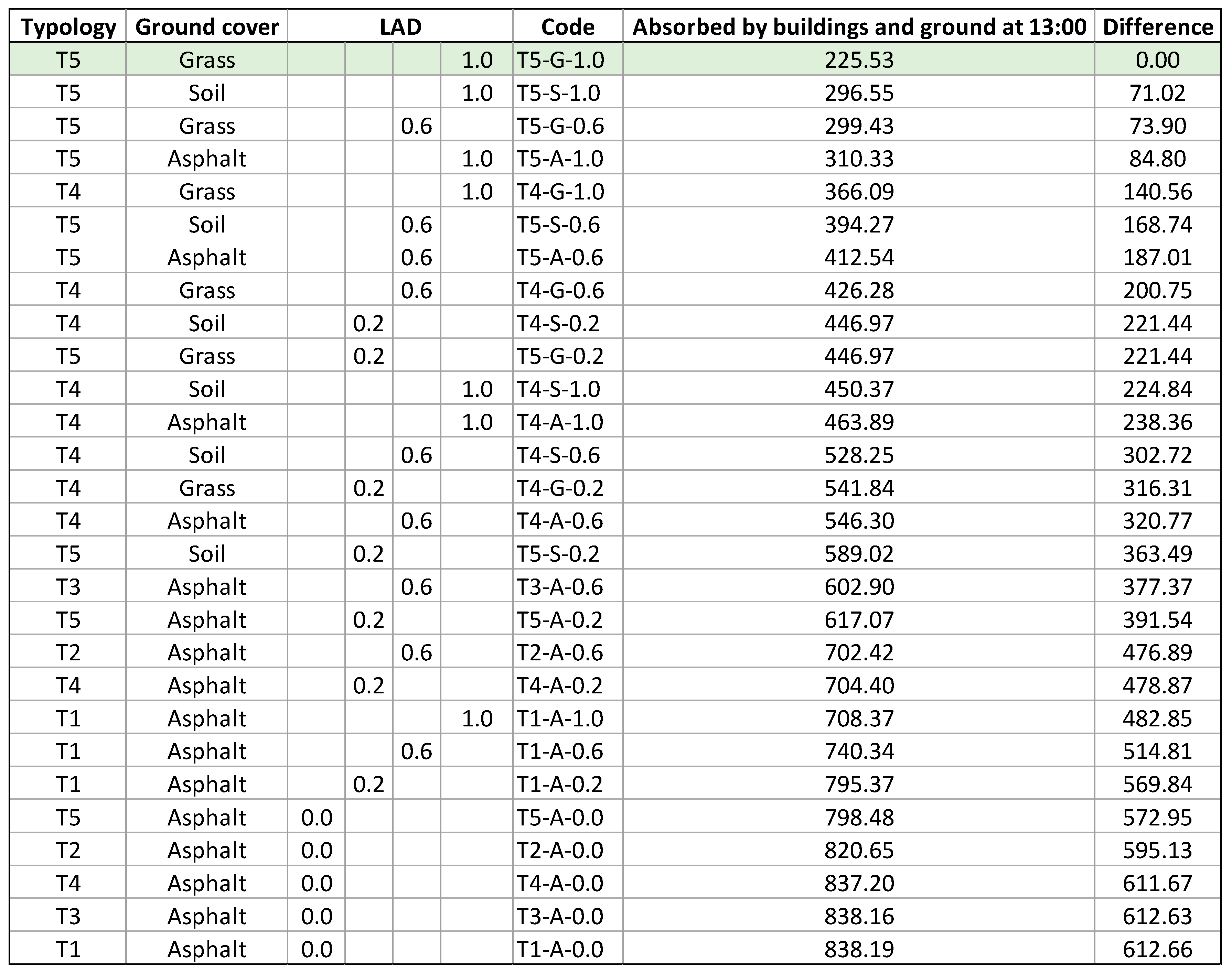
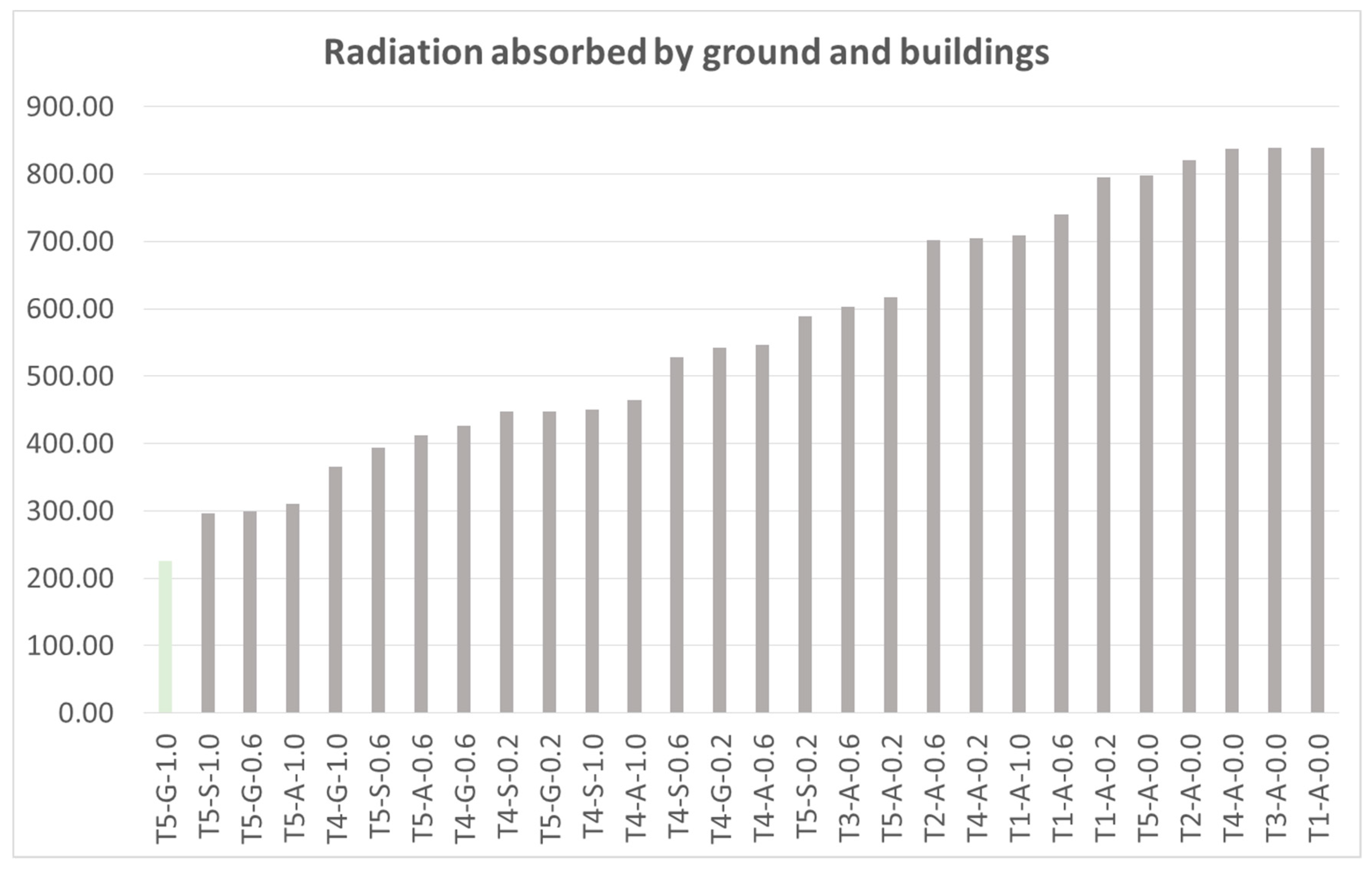
References
- Patz, D.; Engelberg, J.L. The effects of changing weather on public health. Annu. Rev. Public Health 2000, 21, 271–307. [Google Scholar] [CrossRef] [PubMed]
- Grimm, N.B.; Faeth, S.H.; Golubiewski, N.E.; Redman, C.L.; Wu, J.; Bai, X.; Briggs, J.M.; Grimm, N.B.; Faeth, S.H.; Golubiewski, N.E.; et al. Global Change and the Ecology of Cities. Science 2008, 319, 756–760. [Google Scholar] [CrossRef] [PubMed]
- Georgi, J.N.; Dimitriou, D. The contribution of urban green spaces to the improvement of environment in cities: Case study of Chania, Greece. Build. Environ. 2010, 45, 1401–1414. [Google Scholar] [CrossRef]
- Akbari, H. Shade trees reduce building energy use and CO2 emissions from power plants. Environ. Pollut. 2002, 116, 119–126. [Google Scholar] [CrossRef]
- Oke, T.R. The energetic basis of the urban heat island. Q. J. R. Meteorol. Soc. 1982, 108. [Google Scholar] [CrossRef]
- Nice, K.A.; Coutts, A.M.; Tapper, N.J. Urban Climate Development of the VTUF-3D v1.0 urban micro-climate model to support assessment of urban vegetation in fl uences on human thermal comfort. Urban Clim. 2018, 24, 1052–1076. [Google Scholar] [CrossRef]
- Landier, L.; Gastellu-Etchegorry, J.P.; Al Bitar, A.; Chavanon, E.; Lauret, N.; Feigenwinter, C.; Mitraka, Z.; Chrysoulakis, N. Calibration of urban canopies albedo and 3D shortwave radiative budget using remote-sensing data and the DART model. Eur. J. Remote Sens. 2018, 51, 739–753. [Google Scholar] [CrossRef]
- Myint, S.W.; Brazel, A.; Okin, G.; Buyantuyev, A. Combined Effects of Impervious Surface and Vegetation Cover on Air Temperature Variations in a Rapidly Expanding Desert City. GISci. Remote Sens. 2010, 47, 301–320. [Google Scholar] [CrossRef]
- Simpson, J.R. Improved estimates of tree-shade effects on residential energy use. Energy Build. 2002, 34, 1067–1076. [Google Scholar] [CrossRef]
- Gros, A.; Bozonnet, E.; Inard, C. Modelling the radiative exchanges in urban areas: A review. Adv. Build. Energy Res. 2011, 5, 163–206. [Google Scholar] [CrossRef]
- Bruse, M.; Huttner, S. Numerical modeling of the urban climate-a preview on ENVI-MET 4.0. In Proceedings of the Seventh International Conference on Urban Climate, Yokohama, Japan, 29 June–3 July 2009; pp. 1–4. [Google Scholar]
- Lindberg, F.; Holmer, B.; Thorsson, S. SOLWEIG 1.0-Modelling spatial variations of 3D radiant fluxes and mean radiant temperature in complex urban settings. Int. J. Biometeorol. 2008, 52, 697–713. [Google Scholar] [CrossRef]
- Govaerts, Y.M.; Verstraete, M.M. Raytran: A Monte Carlo ray-tracing model to compute light scattering in three-dimensional heterogeneous media. IEEE Trans. Geosci. Remote Sens. 1998, 36, 493–505. [Google Scholar] [CrossRef]
- Disney, M.I.; Lewis, P.E.; Bouvet, M.; Prieto-Blanco, A.; Hancock, S. Quantifying surface reflectivity for spaceborne lidar via two independent methods. IEEE Trans. Geosci. Remote Sens. 2009, 47, 3262–3271. [Google Scholar] [CrossRef]
- Kobayashi, H.; Iwabuchi, H. A coupled 1-D atmosphere and 3-D canopy radiative transfer model for canopy reflectance, light environment, and photosynthesis simulation in a heterogeneous landscape. Remote Sens. Environ. 2008, 112, 173–185. [Google Scholar] [CrossRef]
- Govaerts, Y.; Verstraete, M.M. Modeling the scattering of light in three-dimensional canopies: Contribution of a Monte Carlo ray tracing approach. In Proceedings of the Conference Second Topical Symposium on Combined Optical-Microwave Earth and Atmosphere Sensing, Atlanta, GA, USA, 3–6 April 1995; pp. 31–34. [Google Scholar]
- Gastellu-Etchegorry, J. Discrete Anisotropic Radiative Transfer (DART 5) for Modeling Airborne and Satellite Spectroradiometer and LIDAR Acquisitions of Natural and Urban Landscapes. Remote Sens. 2015, 7, 1667–1701. [Google Scholar] [CrossRef]
- Gastellu-Etchegorry, J. Modeling Radiative Transfer in Heterogeneous 3-D Vegetation Canopies. Remote Sens. Environ. 1996, 58, 131–156. [Google Scholar] [CrossRef]
- Gastellu-Etchegorry, J.P.; Lauret, N.; Yin, T.; Landier, L.; Kallel, A.; Malenovský, Z.; Al Bitar, A.; Aval, J.; Benhmida, S.; Qi, J.; et al. DART: Recent advances in remote sensing data modeling with atmosphere, polarization, and chlorophyll fluorescence. IEEE J. Sel. Top. Appl. Earth Obs. Remote Sens. 2017, 10, 2640–2649. [Google Scholar] [CrossRef]
- Widlowski, J.L.; Taberner, M.; Pinty, B.; Bruniquel-Pinel, V.; Disney, M.; Fernandes, R.; Gastellu-Etchegorry, J.P.; Gobron, N.; Kuusk, A.; Lavergne, T.; et al. Third Radiation Transfer Model Intercomparison (RAMI) exercise: Documenting progress in canopy reflectance models. J. Geophys. Res. Atmos. 2007, 112, 1–28. [Google Scholar] [CrossRef]
- Widlowski, J.; Mio, C.; Disney, M.; Adams, J.; Andredakis, I.; Atzberger, C.; Brennan, J.; Busetto, L.; Chelle, M.; Ceccherini, G.; et al. The fourth phase of the radiative transfer model intercomparison (RAMI) exercise: Actual canopy scenarios and conformity testing. Remote Sens. Environ. 2015, 169, 418–437. [Google Scholar] [CrossRef]
- Li, X.; Koh, T.; Panda, J.; Norford, L.K. Impact of urbanization patterns on the local climate of a tropical city, Singapore: An ensemble study. J. Geophys. Res. Atmos. 2016, 4386–4403. [Google Scholar] [CrossRef]
- Chow, W.T.L.; Roth, M. Temporal dynamcs of the urban heat island of Singapore. Int. J. Clim. 2006, 2260, 2243–2260. [Google Scholar] [CrossRef]
- Updike, T.; Comp, C. Radiometric Use of WorldView-2 Imagery Technical Note. DigitalGlobe 2010, 1–17. [Google Scholar]
- ITT Visual Information Solutions. FLAASH Module User’s Guide; Harris Geospatial Solutions: Boulder, CO, USA, 2006. [Google Scholar]
- ITT Visual Information Solutions. Workflow Tools in ENVI; Whitepaper; Harris Geospatial Solutions: Boulder, CO, USA.
- Vosselman, G. Slope based filtering of laser altimetry data. Int. Arch. Photogramm. Remote Sens. Spat. Inf. Sci. 2000, XXXIII/3, 935–942. [Google Scholar]
- Lee, S.; Wolberg, G.; Shin, S.Y. Scattered data interpolation with multilevel b-splines. IEEE Trans. Vis. Comput. Graph. 1997, 3, 228–244. [Google Scholar] [CrossRef]
- Grau, E.; Durrieu, S.; Fournier, R.; Gastellu-etchegorry, J.; Yin, T. Estimation of 3D vegetation density with Terrestrial Laser Scanning data using voxels. A sensitivity analysis of influencing parameters. Remote Sens. Environ. 2017, 191, 373–388. [Google Scholar] [CrossRef]
- Béland, M.; Widlowski, J.; Fournier, R.A.; Verstraete, M.M. Estimating leaf area distribution in savanna trees from terrestrial LiDAR measurements. Agric. For. Meteorol. 2011, 151, 1252–1266. [Google Scholar] [CrossRef]
- Béland, M.; Widlowski, J.L.; Fournier, R.A. A model for deriving voxel-level tree leaf area density estimates from ground-based LiDAR. Environ. Model. Softw. 2014, 51, 184–189. [Google Scholar] [CrossRef]
- Liang, S.; Li, X.; Wang, J. Fraction of Absorbed Photosynthetically Active Radiation by Green Vegetation. In Advanced Remote Sensing; Academic Press: Cambridge, MA, USA, 2012; Chapter 12. [Google Scholar]
- Roth, M.; Jansson, C.; Velasco, E. Multi-year energy balance and carbon dioxide fluxes over a residential neighbourhood in a tropical city. Int. J. Climatol. 2017, 37, 2679–2698. [Google Scholar] [CrossRef]
- Yuan, C.; Shan, R.; Zhang, Y.; Li, X.X.; Yin, T.; Hang, J.; Norford, L. Multilayer urban canopy modelling and mapping for traffic pollutant dispersion at high density urban areas. Sci. Total Environ. 2019, 647, 255–267. [Google Scholar] [CrossRef]
- Mughal, M.O.; Li, X.; Yin, T.; Martilli, A.; Brousse, O.; Dissegna, M.A.; Norford, L.K. High-resolution, multi-layer modelling of Singapore’s urban climate incorporating local climate zones. J. Geophys. Res. Atmos. 2019. [Google Scholar] [CrossRef]

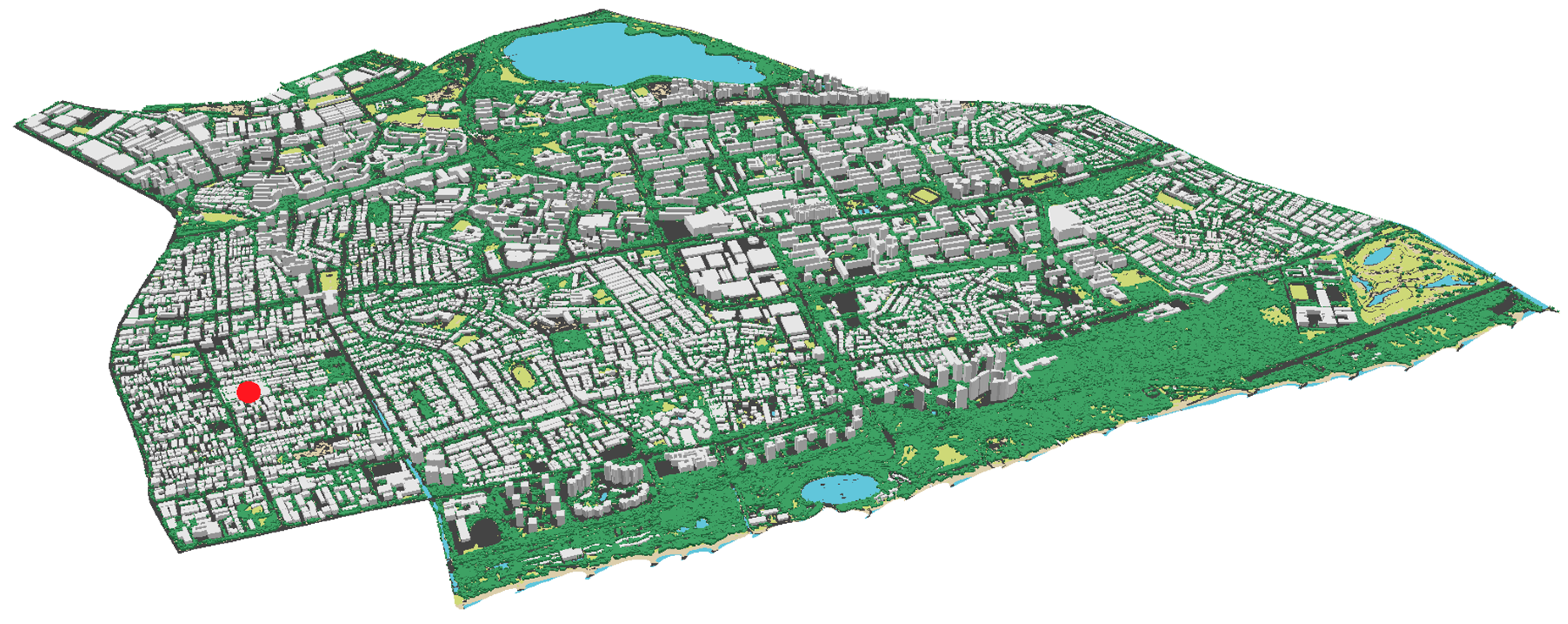
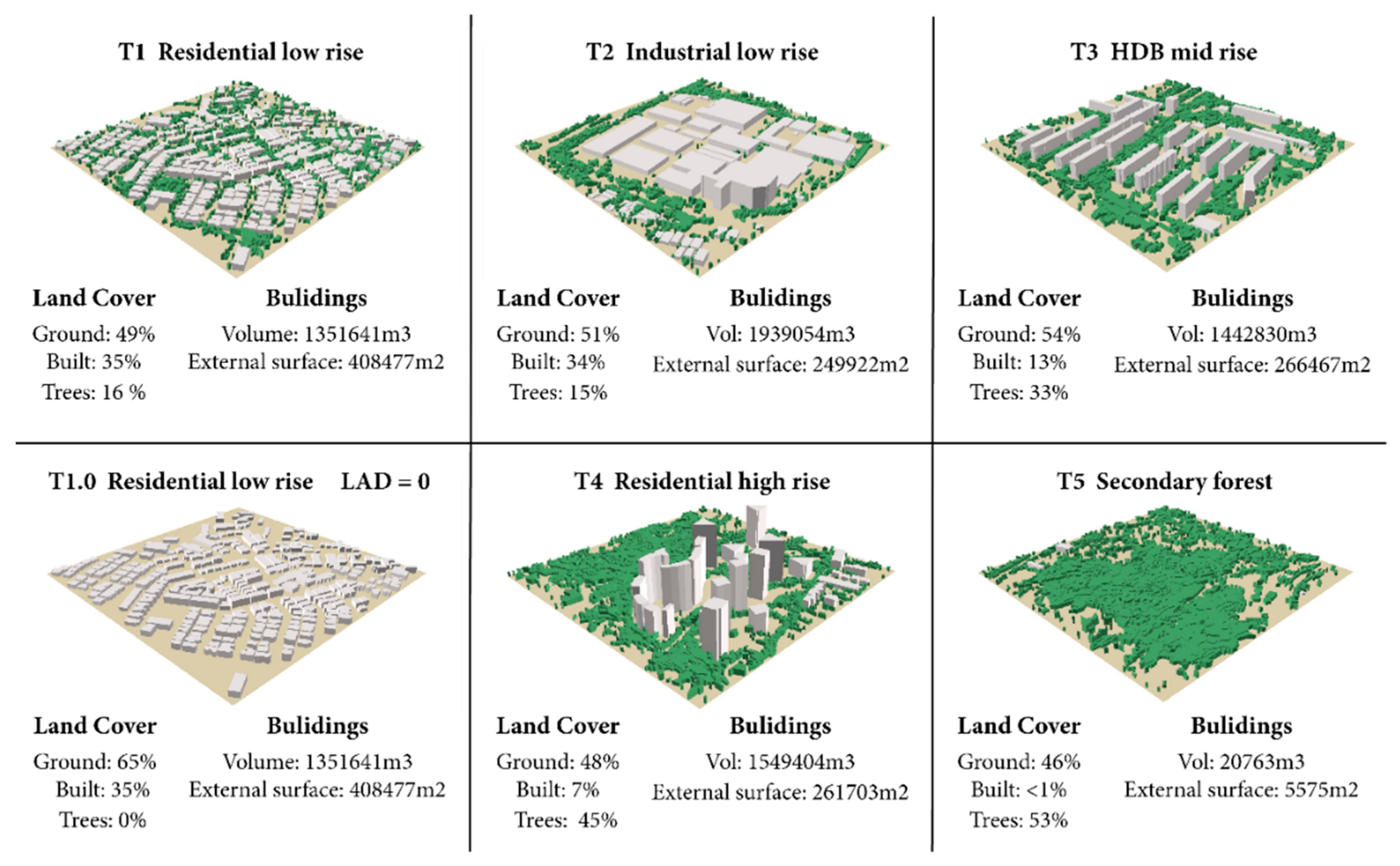
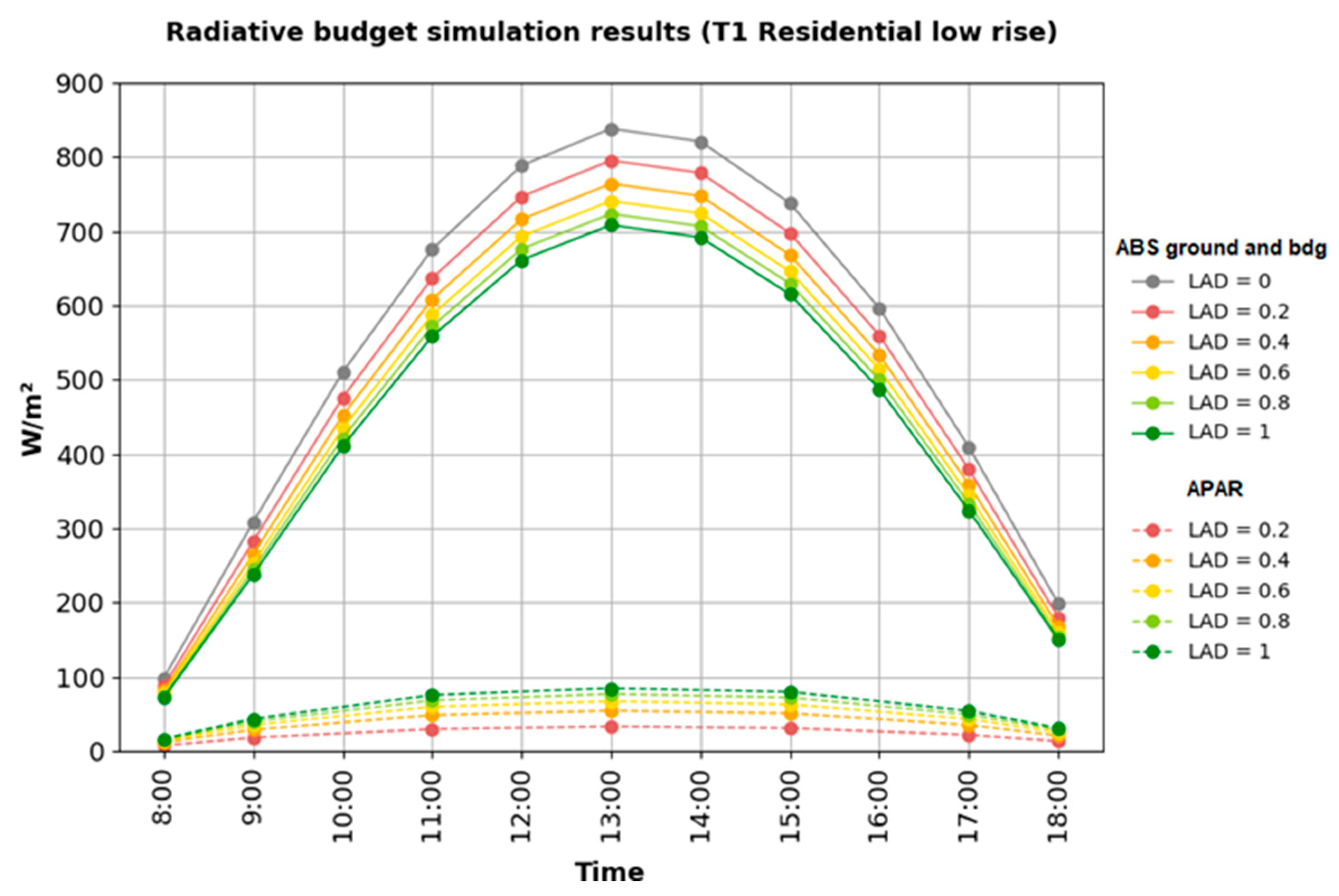
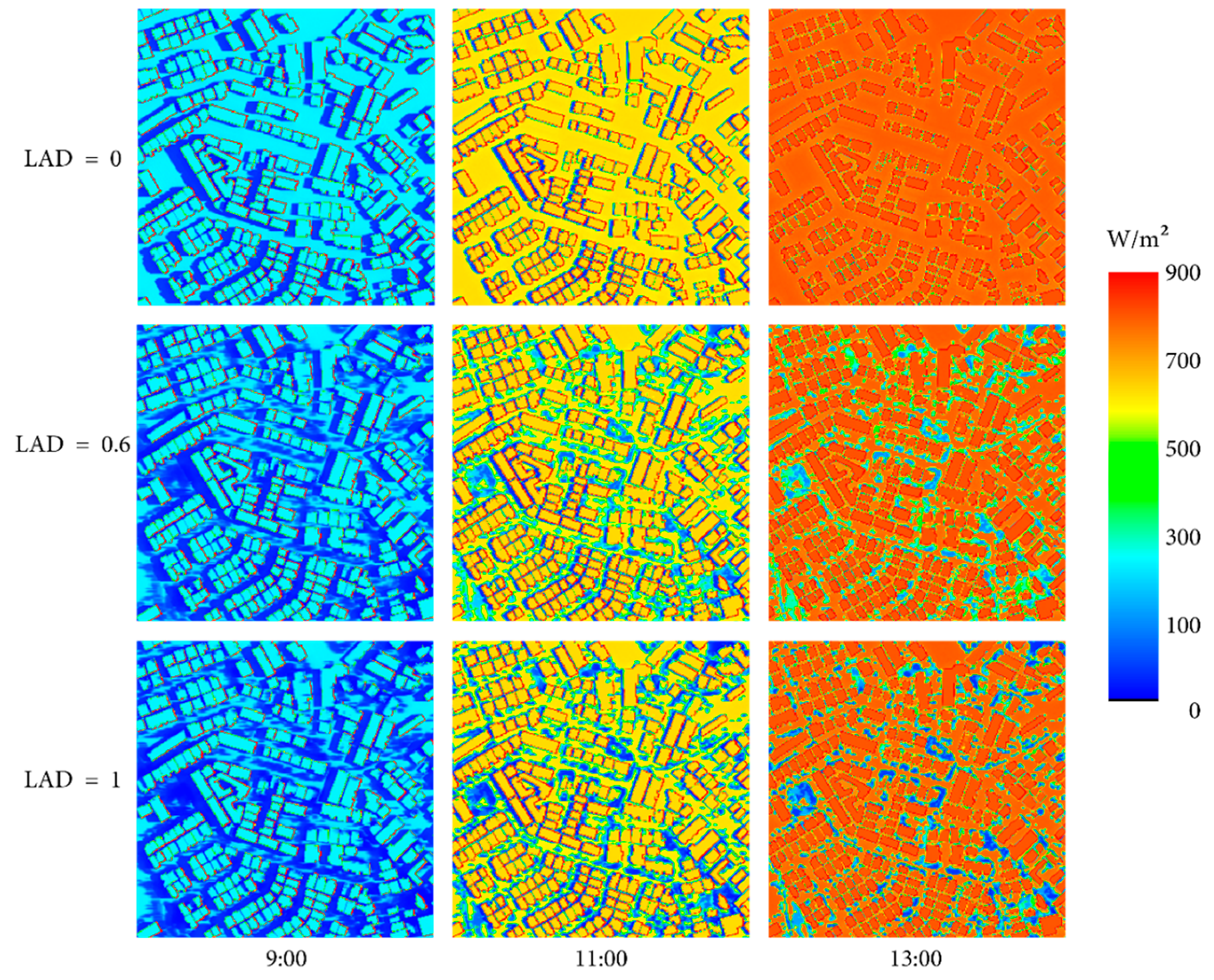


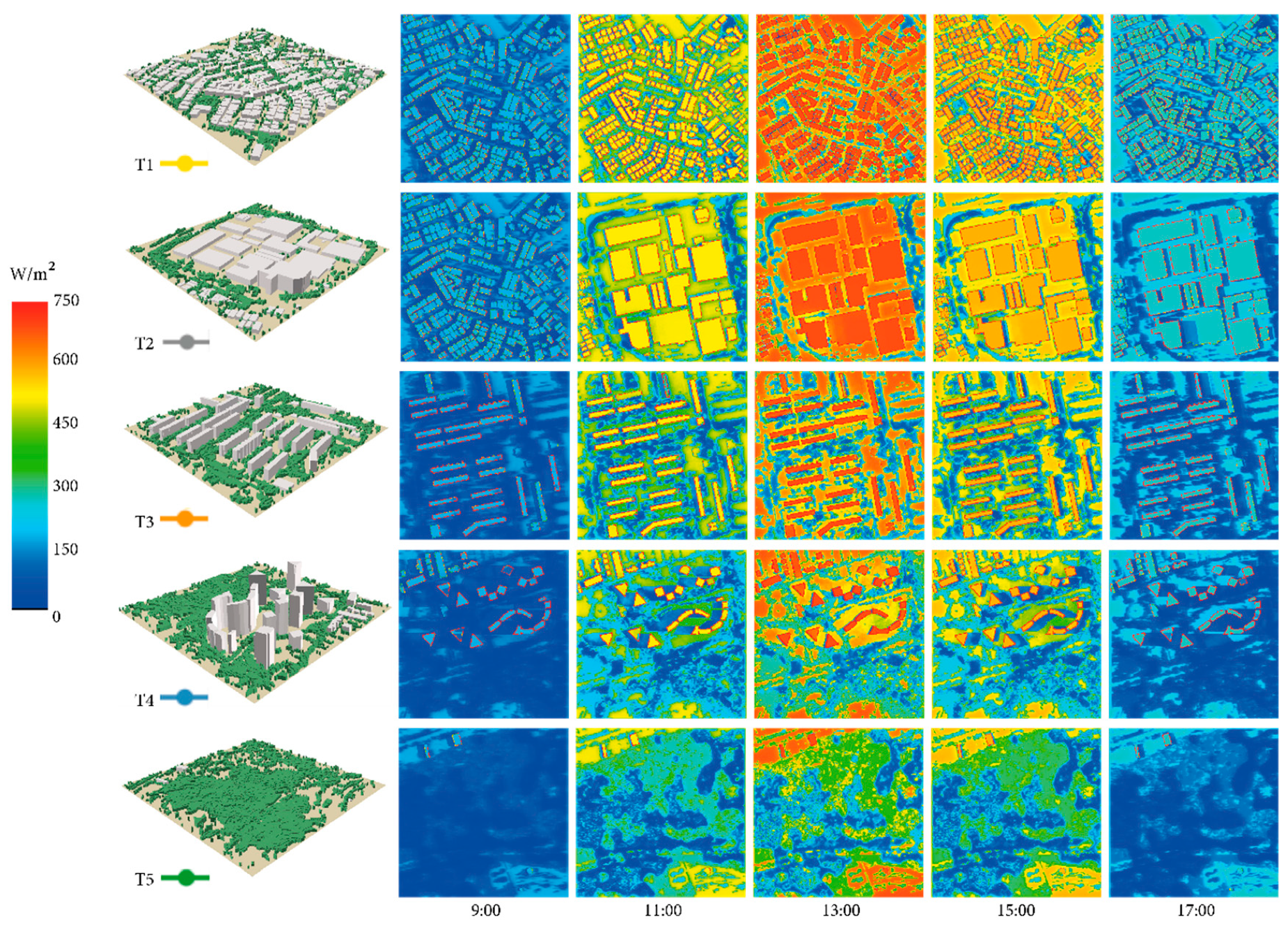
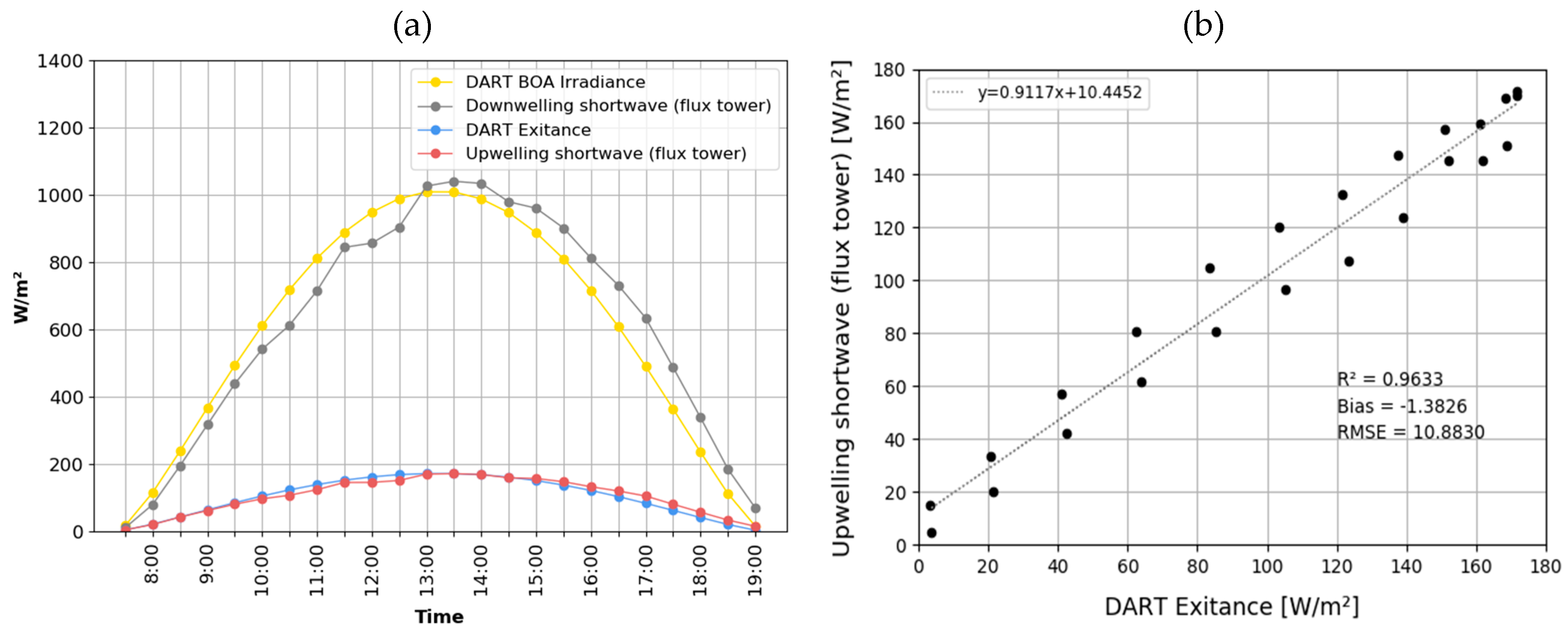
© 2019 by the authors. Licensee MDPI, Basel, Switzerland. This article is an open access article distributed under the terms and conditions of the Creative Commons Attribution (CC BY) license (http://creativecommons.org/licenses/by/4.0/).
Share and Cite
Dissegna, M.A.; Yin, T.; Wei, S.; Richards, D.; Grêt-Regamey, A. 3-D Reconstruction of an Urban Landscape to Assess the Influence of Vegetation in the Radiative Budget. Forests 2019, 10, 700. https://doi.org/10.3390/f10080700
Dissegna MA, Yin T, Wei S, Richards D, Grêt-Regamey A. 3-D Reconstruction of an Urban Landscape to Assess the Influence of Vegetation in the Radiative Budget. Forests. 2019; 10(8):700. https://doi.org/10.3390/f10080700
Chicago/Turabian StyleDissegna, Maria Angela, Tiangang Yin, Shanshan Wei, Dan Richards, and Adrienne Grêt-Regamey. 2019. "3-D Reconstruction of an Urban Landscape to Assess the Influence of Vegetation in the Radiative Budget" Forests 10, no. 8: 700. https://doi.org/10.3390/f10080700
APA StyleDissegna, M. A., Yin, T., Wei, S., Richards, D., & Grêt-Regamey, A. (2019). 3-D Reconstruction of an Urban Landscape to Assess the Influence of Vegetation in the Radiative Budget. Forests, 10(8), 700. https://doi.org/10.3390/f10080700






